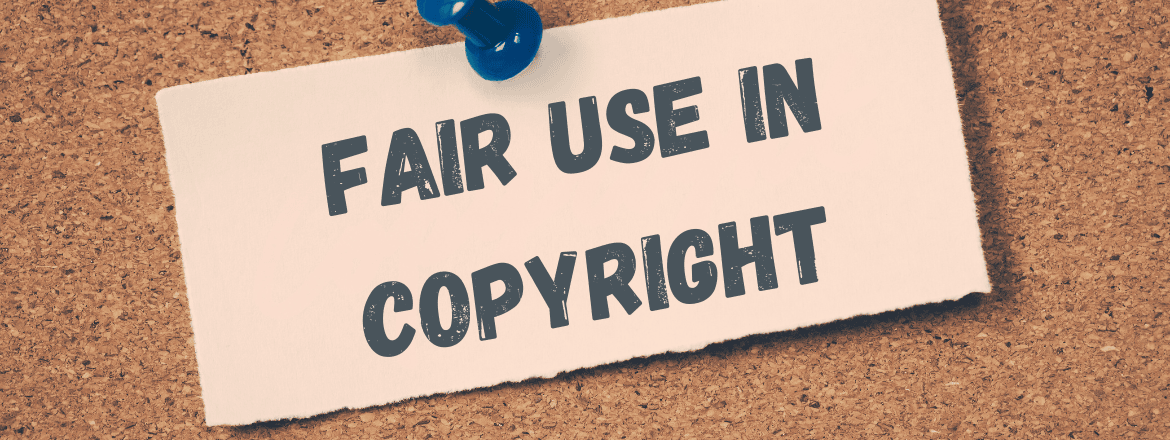Fair Use in Copyright: Guidelines and Examples

Table of Contents
What is Fair Use?
Fair use is a fundamental principle in copyright law that allows the public to use parts of copyrighted materials without seeking specific permission from the copyright holders. While there is no precise definition of what constitutes fair use, the ultimate goal is to create exceptions for using copyrighted information in specific settings.
Some general perceptions of what may be regarded as fair use include, but are not limited to:
- Comment
- Criticism
- Research
- Teaching
- Scholarship
- Remix and Mashups
- Parody
- New Reporting
- Thumbnails
It's crucial to remember that these classifications are not considered complete exemptions of copyright regulations. As fair use is inherently a very slippery slope, decisions regarding them are decided case by case.
How is Fair Use Measured?
Due to the subjective nature of fair use, the legal system is frequently the final authority in charge of copyright disputes. When evaluating a case, judges consider four important factors:
- Purpose and Character: This has to do with how the copyrighted work is intended to be used and if it enhances or contributes to the original work in any way.
- Nature of the Work: Judges consider the intrinsic qualities of the copyrighted content, including its degree of originality and creativity.
- Amount Used: The significance of the use is evaluated by carefully examining how much of the copyrighted information is integrated into the new work.
- Commercial Impact: Courts assess whether the new work negatively impacts the market value or potential earnings of the original material.
It's important to realize that these are only recommendations, and courts have the authority to interpret these factors however they see fit, taking into account the variables of each case. Because judges apply different interpretations, it can be difficult to foresee how fair use cases will turn out.
Four Statutory Factors for Fair Use
1. Purpose and Character of the Use
This factor explores how a user’s work transforms the original material in contrast to it. It evaluates whether the use only replicates copyrighted content or if it helps to create something new and unique.
When grappling with segments of copyrighted material, it's imperative to consider:
- Whether the updated material provides genuine expression and significance, progressing from the source material it uses.
- Whether the original work gains added value through the incorporation of new information, aesthetics, insights, or understandings.
Example of Fair Use: A filmmaker creates a documentary about the history of Jazz Music. In the documentary, the creator uses brief snippets of copyrighted jazz recordings to show how the genre has changed over time. The overall purpose of the film is to be transformative by being educational and provide context for the music genre.
2. The Nature of the Copyrighted Work
Works of fiction, such as books or music, tend to violate fair use rules more frequently than non-fiction works, such as factual publications, scientific papers, and other educational resources meant for general public consumption.
People can generally take more liberties when replicating from authentic sources. This is mostly because it is seen that the distribution of factual knowledge and information is beneficial to the public.
It's important to understand, though, that this laxity might not apply to unpublished works, since writers still have the authority to decide how their works are first seen by the public.
Example of Fair Use: A World War II lesson is being prepared by a high school history teacher. The teacher chooses to enrich the course by adding quotes from historical records, like Winston Churchill speeches or wartime photos. Although some items are protected by copyright, they are more likely to be regarded as fair use because they are factual works.
Because historical documents are regarded as factual and educational rather than completely creative, the nature of the copyrighted work in this case goes towards fair use. The excerpts are meant to enhance students' learning experiences by giving them real historical context, and the teacher's goal in using these resources is to provide instruction.


3. The Amount and Substantiality of the Portion Taken
Determining the amount of borrowing from an original work that is permitted under fair use can be difficult. The idea generally states that a work is less likely to be considered fair usage the more it is drawn from.
Fair use, however, could be supported by cases such as research, educational use, or personal use. On the other hand, the fair use argument is generally weakened if someone, other than the copyright holder, commercially profits off of the original source.
It is important to acknowledge that this particular factor incorporates both qualitative and quantitative evaluations. Reproducing what is commonly referred to as the "Heart of the work," or the most recognizable or memorable portions of the original work, can occasionally compromise the validity of the fair use claim.
For example, Vanilla Ice's 1990 hit track "Ice Ice Baby" included a riff that was similar to the opening riff of Queen and David Bowie's song "Under Pressure," which sparked a legal battle and required credit to the original artists.
Example of Fair Use: A blogger composing a piece about well-known movie phrases on social media. They would like to use a line from the classic movie "The Godfather" in their message. They simply quote a brief passage from the conversation, rather than the whole thing: "I'm gonna make him an offer he can't refuse."
The user's use of a brief excerpt from this copyrighted quote for their blog post is unlikely to have an impact on the original work's market value. Furthermore, the user's blog post complements the film rather than taking the place of it in terms of commentary and information.
4. Effect on the Potential Market for or Value of the Work
This factor largely assesses whether using the original work could jeopardize the economic interests or prospective income of the copyright owner by, for example, preventing the copyrighted product from reaching its full market potential.
Even in cases where one is not directly competing with the original work, the probability of facing legal action is greatly increased when one causes financial injury to a copyright owner. Courts acknowledge that obtaining licenses or approvals is crucial to the value of copyrighted works. However, this element by itself is unable to establish with certainty whether a particular usage is fair.
When positioned as the fourth factor, evaluating market effects becomes a little bit straightforward. Considerations of market harm should be given less weight if all three of the previous factors favor fair use. On the other hand, market harm takes on more weight in the balancing of these considerations if the previous factors do not favor fair use.
Example of Fair Use: A bakery distributes recipe cards for its renowned chocolate chip cookies. To increase traffic, a food blogger shares the recipe on their blog.
Customers may be less likely to buy the bakery's recipe cards if they can get the recipe for free online, which could have an effect on the bakery's prospective revenue. Since it might hurt the original author's market, the blogger's usage of the recipe might not be deemed fair use in this instance.
Conclusion
In copyright law, fair use principles provide flexibility by striking a balance between the rights of creators and public access to knowledge. Fair use encourages appropriate interaction with copyrighted content and is determined by elements such as goal and market impact. In today's digital environment, an understanding of these principles encourages the ethical and creative use of content.
With Abou Naja Intellectual Property, we can guarantee that you will receive the best professional advice on how to protect your creative work while traversing the intricacies of fair usage. To ensure that your intellectual property rights remain secure in the digital age, get in touch with us immediately for specialized legal solutions. Get in touch with us at [email protected] for a complimentary consultation.






